It was early morning. The gates to
the dead city hadn’t opened yet. Silence filled the streets once
teeming with people, shopping, conversing, going about their
business. What remains of the buildings speaks volumes about life
here in 79 C.E., the day when life as the Roman residents of Pompeii
knew it would end.

What strikes the visitor more than anything else is the horrific
casts of the people, caught in the moment of death, surprise on many
of their faces. It’s something a person doesn’t easily forget. So
much rests on the preserved agony in their faces that visitors
forget about what life was like here.
But somehow what remains of Roman Pompeii is magical. The tons and
tons of ash softly and swiftly buried the residents of Pompeii,
their culture, their lives. And in doing so preserved it for
generations. Buried deep under the ash were elegant homes with
colonnades and floors of earth colored mosaics.
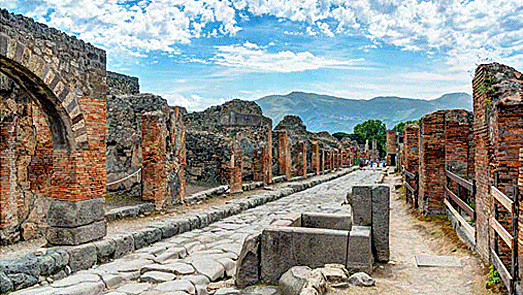
Shops opened for business early that morning. Shopkeepers filled the
amphora with wine and prepared to bake bread for the day’s lunch.
Later, the ash encased the loaves, turning them into hard remnants
of themselves.
The inhabitants of Pompeii had long been used to minor earthquakes,
but on February 5, 62 CE a severe earthquake did considerable damage
around the bay, especially in Pompeii. Volcanologists believe the
earthquake would have registered between 5 and 6 on the Richter
scale.
Mt. Vesuvius Erupts
It was on the afternoon of August 24, 79 CE, that people living
around the long-dormant Mount Vesuvius watched in awe as flames shot
suddenly from the 4,000-foot volcano, followed by a huge black
cloud. A witness later wrote that sometimes it looked white,
sometimes blotched and dirty, according to the amount of soil and
ashes it carried with it.
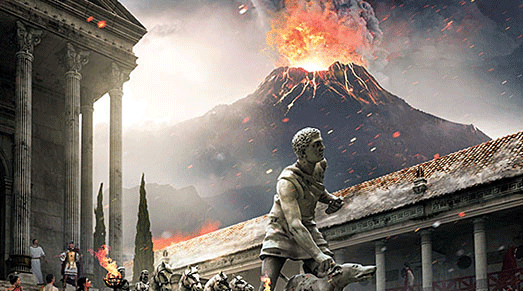
Volcanologists estimate that the eruptive column expelled from the
cone rose as high as 20 miles. Soon a rain of soft pumice, or
lapilli, and ash began falling over the countryside. That evening,
broad sheets of fire and leaping flames blazed at several points on
the mountain, their bright glare emphasized by the darkness of
night.
Many people fled as soon as they saw
the eruption. But the lapilli gathered deadly force, the weight
collapsing roofs and crushing stragglers as they sought protection
beneath staircases and under beds. Others choked to death on
thickening ash and noxious clouds of sulfurous gas. Doomed by its
proximity to Vesuvius, the ash entombed Pompeii within a day.
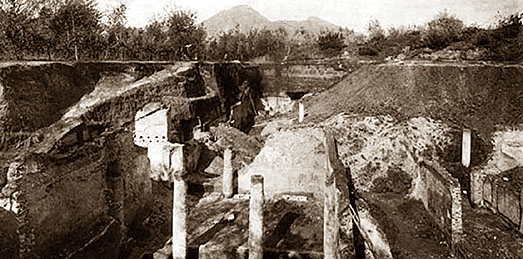
The eruption lasted for two days. The first phase rained pumice for
18 hours, allowing most inhabitants to escape. So far, only about
1,150 bodies have so far been found on site. Most escapees probably
managed to salvage some of their most valuable belongings—jewelry,
silverware, coins.
At some time during the night or early the next day, pyroclastic
flows, consisting of high speed, dense, and very hot ash clouds,
began near the volcano. Knocking down wholly or partly all
structures in their path, the flows incinerated or suffocated the
remaining population and altered the landscape. By evening of the
second day, the eruption had ceased, leaving only haze in the
atmosphere which bloated out the sun.
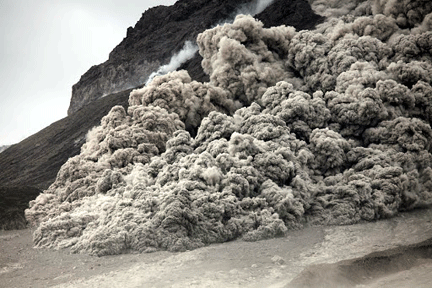
Most people died from the intense heat, not from suffocation as
archaeologists previously believed. Exposure to at least 480 °Fat a
distance of 10 kilometres (6 miles) from the vent was sufficient to
cause instant death, even if people were sheltered within. Up to 12
different layers of tephra, up to19.7 feet deep covered the people
and buildings of Pompeii.
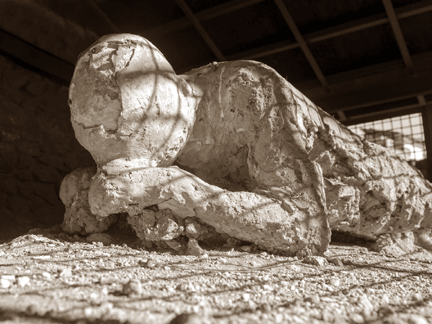 Soon
after the eruption ceased, survivors and possibly thieves came to
salvage valuables, including the marble statues from the forum and
other precious materials from buildings. Archaeologists discovered
they had made holes through walls. The tops of larger buildings rose
above the ash, making it obvious where to dig or salvage building
material. The robbers left traces such as a wall graffito saying
"house dug." Further eruptions covered the city more deeply.
Soon
after the eruption ceased, survivors and possibly thieves came to
salvage valuables, including the marble statues from the forum and
other precious materials from buildings. Archaeologists discovered
they had made holes through walls. The tops of larger buildings rose
above the ash, making it obvious where to dig or salvage building
material. The robbers left traces such as a wall graffito saying
"house dug." Further eruptions covered the city more deeply.
Pompeii remained largely undisturbed, lost to history, through the
rise of Byzantium, the Middle Ages, and the Renaissance.
Antiquities Discovered
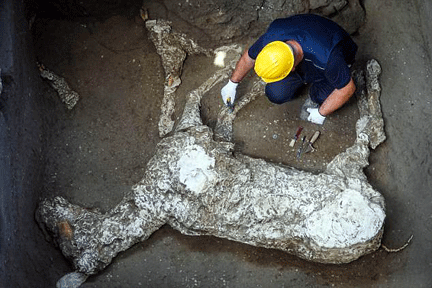 A
French prince digging in the vicinity of his villa on Mount Vesuvius
had discovered the antiquities nearly 30 years earlier, but he never
conducted a systematic excavation. So he dispatched teams of
laborers and engineers equipped with tools and blasting powder to
the site of the original dig to hunt for more treasures at the site.
For months, they tunneled through 60 feet of rock-hard lava,
unearthing painted columns, sculptures of Roman figures draped in
togas, the bronze torso of a horse—and a flight of stairs. Not far
from the staircase they came to an inscription, “Theatrum
Herculanense.” They had uncovered a Roman-era town, Herculaneum.
A
French prince digging in the vicinity of his villa on Mount Vesuvius
had discovered the antiquities nearly 30 years earlier, but he never
conducted a systematic excavation. So he dispatched teams of
laborers and engineers equipped with tools and blasting powder to
the site of the original dig to hunt for more treasures at the site.
For months, they tunneled through 60 feet of rock-hard lava,
unearthing painted columns, sculptures of Roman figures draped in
togas, the bronze torso of a horse—and a flight of stairs. Not far
from the staircase they came to an inscription, “Theatrum
Herculanense.” They had uncovered a Roman-era town, Herculaneum.
Digging began in Pompeii 10 years later. Workers burrowed far more
easily through the softer deposits of pumice and ash, unearthing
streets, villas, frescoes, mosaics and the remains of the dead. The
skeleton of a man lay outstretched on the floor with gold and silver
coins that had rolled out of his bony hands still seeking, it
seemed, to clutch them fast.
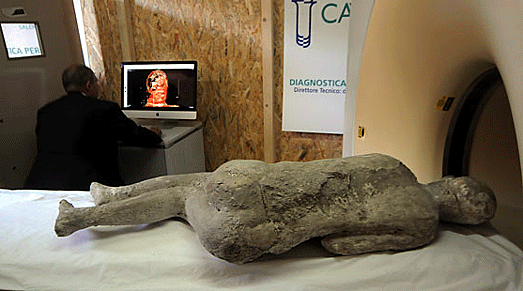
In the 1860s a pioneering Italian archaeologist at Pompeii, Giuseppe
Fiorelli, poured liquid plaster into the cavities in the solidified
ash created by the decomposing flesh, creating perfect casts of
Pompeii’s victims at the moment of their deaths—down to the folds in
their togas, the straps of their sandals, their agonized facial
expressions. These morbid tableaux thrilled early visitors on the
Grand Tour.
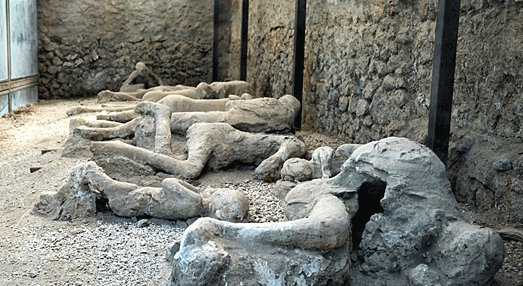
Largely preserved under the ash, the excavated remains of Pompeii
offered a unique snapshot of Roman life, frozen at the moment it was
buried, and an extraordinarily detailed insight into the everyday
life of its inhabitants. However, much of the evidence was lost in
the early excavations.
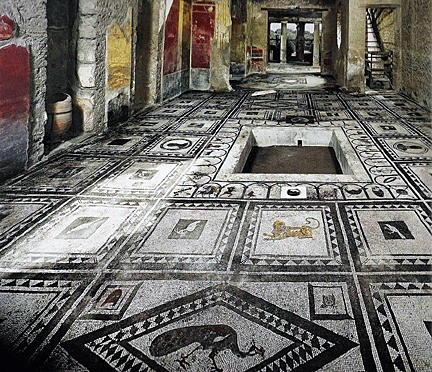 Pompeii
was a wealthy town, with many fine public buildings and luxurious
lavishly decorated private houses, with fine furnishings and works
of art. The volcanic ash entombed organic remains, including wooden
objects and human bodies. Over time, they decayed, leaving voids
which archaeologists used as molds to make plaster casts of
unique—and often gruesome— figures in their final moments of their
lives. The numerous graffiti carved on the walls and inside rooms
provide a wealth of examples of the largely lost Vulgar Latin spoken
colloquially at the time, contrasting with the formal language of
the classical writers.
Pompeii
was a wealthy town, with many fine public buildings and luxurious
lavishly decorated private houses, with fine furnishings and works
of art. The volcanic ash entombed organic remains, including wooden
objects and human bodies. Over time, they decayed, leaving voids
which archaeologists used as molds to make plaster casts of
unique—and often gruesome— figures in their final moments of their
lives. The numerous graffiti carved on the walls and inside rooms
provide a wealth of examples of the largely lost Vulgar Latin spoken
colloquially at the time, contrasting with the formal language of
the classical writers.
The grandeur of Pompeii’s public buildings remains, even in ruin.
The Forum, the preserved administrative and commercial center of the
city, had entrances to the Basilica and Macellum, the Temple of
Jupiter.
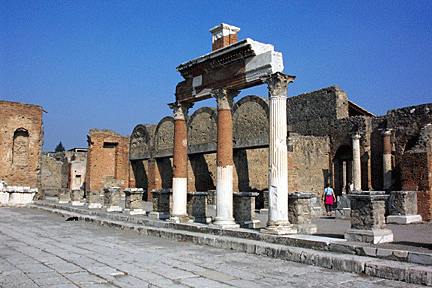 The
city became an important passage for goods that arrived by sea and
had to be sent toward Rome or Southern Italy along the nearby Appian
Way. The Romans built many public buildings or refurbished and
improved others. New ones included the Amphitheatre of Pompeii,
built in 70 BCE, the Forum Baths, and the Odeon. They embellished
the Forum with the colonnade of Popidius before 80 BCE. These
buildings raised the status of Pompeii as a cultural center in the
region, while at the same time outshining its neighbors in the
number of places for entertainment.
The
city became an important passage for goods that arrived by sea and
had to be sent toward Rome or Southern Italy along the nearby Appian
Way. The Romans built many public buildings or refurbished and
improved others. New ones included the Amphitheatre of Pompeii,
built in 70 BCE, the Forum Baths, and the Odeon. They embellished
the Forum with the colonnade of Popidius before 80 BCE. These
buildings raised the status of Pompeii as a cultural center in the
region, while at the same time outshining its neighbors in the
number of places for entertainment.
One of the most glorious of Pompeii’s villas is the House of the
Golden Cupids, a wealthy man’s residence, its interior embellished
with frescoes and mosaics, built around a garden faithfully
reproduced on the basis of period paintings. And there were many
others as Pompeii became a seaside resort for the rich.
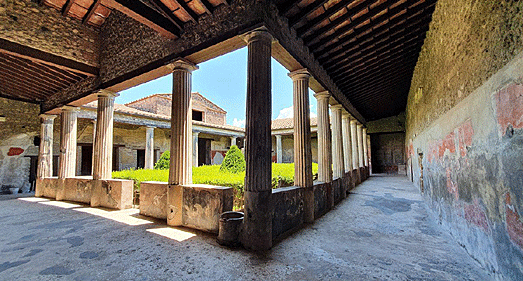
Pompeiian Artifacts
Objects buried beneath Pompeii were well-preserved for almost 2,000
years as the lack of air and moisture allowed little to no
deterioration. However, once exposed, Pompeii has been subject to
both natural and man-made forces, which have rapidly increased
deterioration.
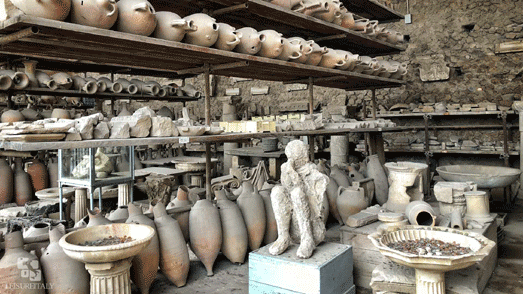
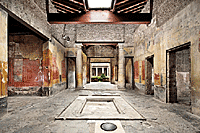 Before
its disastrous end, Pompeii was a thriving city known for its lavish
style. Houses were decorated beautifully, as were the people,
blending art into all aspects of their life. After being buried in
ash and debris, the recovered artifacts of the city remained, giving
archaeologists a better understanding of the people thousands of
years after their time.
Before
its disastrous end, Pompeii was a thriving city known for its lavish
style. Houses were decorated beautifully, as were the people,
blending art into all aspects of their life. After being buried in
ash and debris, the recovered artifacts of the city remained, giving
archaeologists a better understanding of the people thousands of
years after their time.
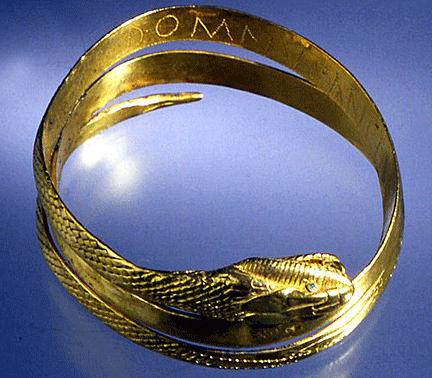 The
residents of Pompeii saw jewelry as a status item—the more a people
had, the higher their status. Jewelry was expensive, so only the
wealthy were able to afford it Jewelry artefacts have been a common
discovery within Pompeii’s ruins. Archaeologists have discovered
skeletons with bracelets still attached or even gripping pieces of
jewelry in desperation. The jewelry worn was typically gold, with a
few gemstones and pearls depending on the piece.
The
residents of Pompeii saw jewelry as a status item—the more a people
had, the higher their status. Jewelry was expensive, so only the
wealthy were able to afford it Jewelry artefacts have been a common
discovery within Pompeii’s ruins. Archaeologists have discovered
skeletons with bracelets still attached or even gripping pieces of
jewelry in desperation. The jewelry worn was typically gold, with a
few gemstones and pearls depending on the piece.
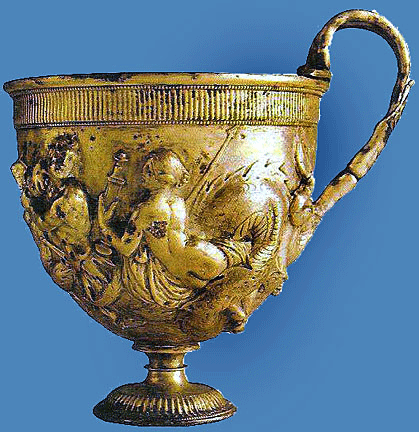 Frescoes,
the most common painting style at the time, are the main form of
artwork found within Pompeii. Artists painted frescos directly onto
the plaster walls using water-based pigments. Many of these works
have given archaeologists a greater understanding of the people of
Pompeii, particularly showing the comfortability they had concerning
their sexual desires. Erotic frescoes adorned the walls of brothels,
promoting the services and positions available. In private homes,
they depicted sensual occurrences between the gods. Many have
survived in varying degrees of completeness.
Frescoes,
the most common painting style at the time, are the main form of
artwork found within Pompeii. Artists painted frescos directly onto
the plaster walls using water-based pigments. Many of these works
have given archaeologists a greater understanding of the people of
Pompeii, particularly showing the comfortability they had concerning
their sexual desires. Erotic frescoes adorned the walls of brothels,
promoting the services and positions available. In private homes,
they depicted sensual occurrences between the gods. Many have
survived in varying degrees of completeness.
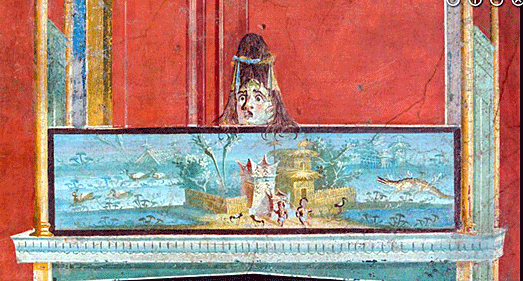
The fresco, on the wall of a 12 -by-16-foot room containing an
altar, a garden, and a small pool, depicts an unusual design of
different beasts, along with a man with the head of a dog, thought
to be inspired by the Egyptian god Anubis.
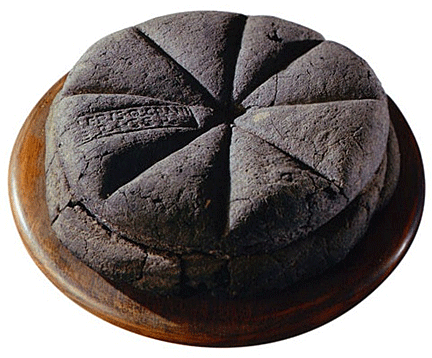 Food
remnants have been one of the most unique finds in Pompeii. They
have helped tell archaeologists what types of food Pompeiians ate.
One of the most fascinating discoveries was a giraffe bone, which
illustrated how the wealthy people of Pompeii sought after the most
exotic food for their dinners made possible by imports from
far-flung areas. Another enthralling find was the discovery of
several carbonized loaves of bread preserved, preserved in charcoal,
looking as if they just came out of the oven. Along with these,
whole eggs, fruit, nuts and fish bones have also been found,
indicating the varied diet the people of Pompeii had. What’s been
highly notable and unexpected is just how healthy this diet was for
people of that time, which was made possible by their convenient
location to the ocean and the fertile volcanic earth.
Food
remnants have been one of the most unique finds in Pompeii. They
have helped tell archaeologists what types of food Pompeiians ate.
One of the most fascinating discoveries was a giraffe bone, which
illustrated how the wealthy people of Pompeii sought after the most
exotic food for their dinners made possible by imports from
far-flung areas. Another enthralling find was the discovery of
several carbonized loaves of bread preserved, preserved in charcoal,
looking as if they just came out of the oven. Along with these,
whole eggs, fruit, nuts and fish bones have also been found,
indicating the varied diet the people of Pompeii had. What’s been
highly notable and unexpected is just how healthy this diet was for
people of that time, which was made possible by their convenient
location to the ocean and the fertile volcanic earth.
Other service buildings that have been undercovered include the
Macellum, or meat market, the Pistrinum, or grain mill, the cauponae,
or cafes with a seedy reputation as hangouts for thieves and
prostitutes, and the Thermopolium, a fast-food place that served hot
and cold dishes and beverages. .
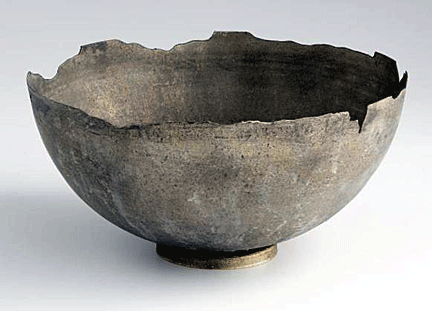 Archaeologists
uncovered a typical Pompeiian thermopolium containing eight dolia,
or terracotta containers, in December 2020. In addition to brightly
colored frescoes, archaeologists revealed some of the 2,000-year-old
foods available in some of the deep terra cotta jars. In the drink
shop, they found a decorated bronze drinking bowl known as a patera,
wine flasks, amphora, ceramic jars used for cooking stews and soups.
One fresco depicts a dog with a collar on a leash, possibly a
reminder for customers to leash their pets.
Archaeologists
uncovered a typical Pompeiian thermopolium containing eight dolia,
or terracotta containers, in December 2020. In addition to brightly
colored frescoes, archaeologists revealed some of the 2,000-year-old
foods available in some of the deep terra cotta jars. In the drink
shop, they found a decorated bronze drinking bowl known as a patera,
wine flasks, amphora, ceramic jars used for cooking stews and soups.
One fresco depicts a dog with a collar on a leash, possibly a
reminder for customers to leash their pets.
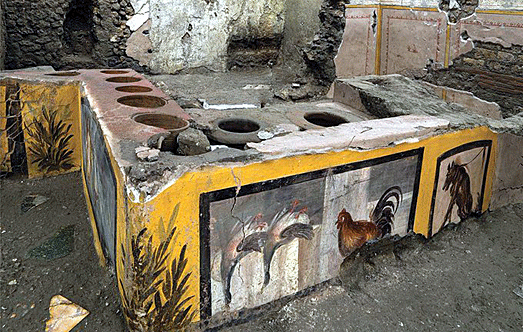
Only recently have archaeologists uncovered a well-preserved
four-wheel ceremonial chariot at a villa north of Pompeii in Civita
Giuliana, where a stable had previously been discovered in 2018. The
carriage is made of bronze with black and red wooden panels, with
stories engraved onto metal medallions at the back.
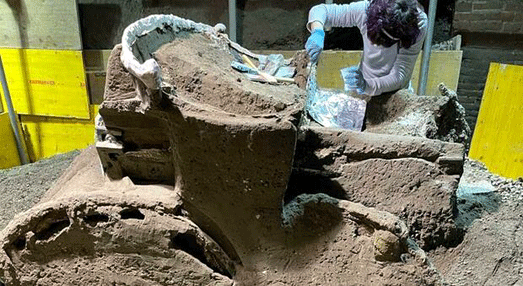
The artifacts uncovered in Pompeii continue to tell stories about
the lives of the people who lived, worked, and played there over
2,000 years ago.
